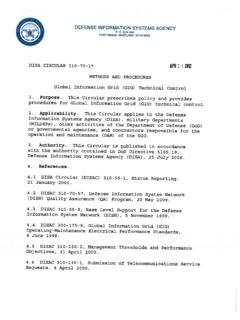Transcription of Defense Technical Information Center Compilation …
1 UNCLASSIFIED. Defense Technical Information Center Compilation Part Notice ADP013484. TITLE: Failure Modes and Predictive Diagnostics Considerations for Diesel Engines DISTRIBUTION: Approved for public release, distribution unlimited This paper is part of the following report: TITLE: New Frontiers in Integrated Diagnostics and Prognostics. Proceedings of the 55th Meeting of the Society for Machinery Failure Prevention Technology. Virginia Beach, Virginia, April 2 - 5, 2001. To order the complete Compilation report, use: ADA412395. The component part is provided here to allow users access to individually authored sections )f proceedings, annals, symposia, etc. However, the component should be considered within [he context of the overall Compilation report and not as a stand-alone Technical report.]
2 The following component part numbers comprise the Compilation report: ADP013477 thru ADP013516. UNCLASSIFIED. FAILURE MODES AND PREDICTIVE DIAGNOSTICS CONSIDERATIONS. FOR DIESEL ENGINES. Jeffrey Banks, Jason Hines, Mitchell Lebold, Robert Campbell, Colin Begg and Carl Byington The PennsylvaniaState University/Applied Research Lab Condition-BasedMaintenance Department University Park,PA, 16804-0030. Abstract: Diesel engines are well known for their operational robustness and efficient performance. These attributes make them a leading choice for prime movers in critical DoD, industrial, and mobility applications. Despite the diesel engine's known reliability, there are some operational issues that justify monitoring critical engine components and subsystems in order to increase the overall availability and readiness of diesel-powered systems.
3 Moreover, engines typically constitute a significant fraction (1/10-1/5) of the acquisition cost and a comparable fraction of the life cycle cost for mobility applications (trucks, armored vehicles), thereby providing the motivation for engine condition monitoring on the basis of reducing life cycle costs. Review of the available literature indicates that the fuel injection and cooling subsystems are among the most problematic on diesel engines contributing to reduced readiness and increased maintenance costs. These faults can be addressed and studied using scaled testing to build the necessary knowledge base to quickly transition the methods to full-scale, more costly diesel engines. Towards this goal, a Diesel Enhanced Mechanical Diagnostics Test Bed (DEMDTB) has been developed that uses an array of sensors to measure pressure, temperature, vibration, and displacement.
4 The test bed is used for experimental collection of healthy, seeded fault, and transitional fault test data from the diesel engine and driveline components. The data is analyzed with time and frequency based analysis methods to characterize 'healthy' and 'faulty' operation. The purpose of this paper is to present an overview of previous research conducted for diesel engine diagnostics, discuss recent diesel engine diagnostics developments, and to lay the basis for straightforward concept designs for practical diesel engine monitoring/diagnostics systems that will enable system prognostics. Key Words: Condition-Based Maintenance (CBM); diesel engines; Diesel Enhanced Mechanical Diagnostics Test Bed (DEMDTB); FMEA.
5 Introduction: Diesel engines are widely used as generators and prime movers in industry and the military for their durability and efficient performance and they are often used in applications where reliability is a crucial operating requirement. Large and 93. medium size diesel engines can be found in electrical power plants as the prime movers of large oceanic vessels. Meanwhile smaller, high-speed engines have been found in tractors, trucks, cars and small marine vessels. Diesel engines are also used for a wide variety of military applications. For example, the US Navy uses diesel engines in a variety of roles in the fleet. Numbering in the thousands, applications for these engines range from main propulsion and service power generation down to fire hose pumps.
6 These engines range in power from less than 50 hp to above 12,000 hp. Diesels are used on roughly 30 classes of ships across the Navy. Currently over 200 diesel engines that are greater than 2,000 hp are being used for main propulsion on the LSD, LST, and PC. class ships [1]. The Army and Marine Corps are also heavily reliant upon diesel engines as prime movers where the majority of combat and transport vehicles in use (with the exception of main battle tanks) are powered by diesel engines. The Advanced Amphibious Assault Vehicle, currently in the acquisition process, uses a high-powered, MTU diesel engine. Some of these systems have a good deal of performance monitoring and limited diagnostics.
7 However, the authors have seen no commercial system with true prognostic capability. Considering the manning reduction issues that the military and many industries are faced with coupled with the need for diesel engine maintainability, it is logical that a Condition-based Maintenance (CBM) system be developed for monitoring diesel engine operation. The justification for implementing a CBM program should be evaluated on a case-by-case basis but when diesel engine dependability is crucial to mission effectiveness, then that system is an excellent candidate for the application of a CBM. program. Financially feasible applications for such advanced maintenance systems are in nuclear power plants, offshore oil rigs, hospitals, and in various remote unmanned facilities.
8 The need for cost-efficient maintenance programs in the military is evident by the overwhelming size and age of the armed forces vehicular fleet. The average age of the military's 850,000 vehicles is twelve years, which makes maintaining operational readiness a paramount concern and also a costly expenditure of more than five billion dollars annually [2]. Operational Characteristics of Diesel Engines: Diesel engines are comparable to spark ignited (SI) engines in many respects, with the exception that they use the heat produced from the compression stroke for ignition rather than spark plugs. Diesel fuel is injected at high pressure into the cylinder after the air has been compressed to such a point where auto-ignition occurs.
9 The compression ratio of diesel engines can be greater than twice that of SI engines, which translates into greater efficiency. The combustion process of the diesel engine is highly dependant upon the precise injection of atomized fuel into the cylinder or swirl chamber. The fuel injection system controls the injection pressure (necessary for atomization and mixture) and dispenses a metered amount of fuel for specified speed and load conditions, and has effects upon emissions and overall engine noise. The reliable operation of the fuel injection/delivery system is thus a paramount concern for both engine manufacturers and maintenance personnel. The development of the distributor-type injection pump with automatic timing (introduced in the early 1960's) and Electronic Diesel Control (developed during the 94.)
10 1970's) have contributed greatly to the increased power output and lower emissions of modem engines [3]. Diesel Engine Fault Analysis: Research efforts related to the development of diesel engine diagnostic systems have typically been guided by a thorough knowledge of component failure modes. A reliability-based engineering method that is commonly employed as an evaluation tool is Failure Mode and Effects Analysis (FMEA). FMEA. charts describe the function of a component, potential failure modes, possible causes of failure, and the effects such failures would have upon the system's operation. Other versions of how to capture this Information are employed in RCM II analysis and FMECA (Failure Modes, Effects and Criticality Analysis).












